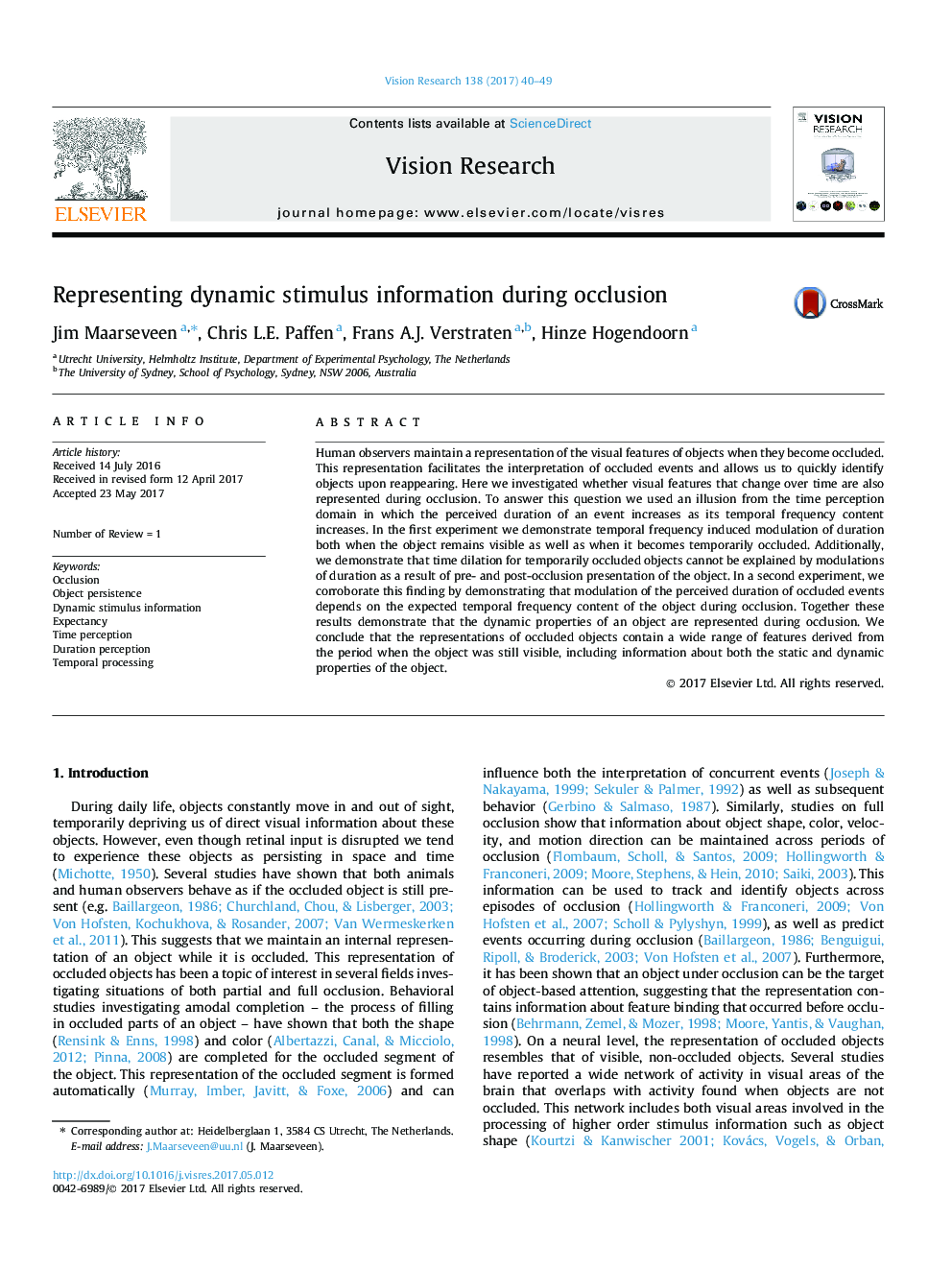| کد مقاله | کد نشریه | سال انتشار | مقاله انگلیسی | نسخه تمام متن |
|---|---|---|---|---|
| 5705844 | 1603161 | 2017 | 10 صفحه PDF | دانلود رایگان |
عنوان انگلیسی مقاله ISI
Representing dynamic stimulus information during occlusion
ترجمه فارسی عنوان
نمایش اطلاعات محرک پویا در هنگام انسداد
دانلود مقاله + سفارش ترجمه
دانلود مقاله ISI انگلیسی
رایگان برای ایرانیان
کلمات کلیدی
وقوع، پایداری شیء، اطلاعات محرک دینامیکی، انتظار ادراک زمان، ادراک طول مدت، پردازش موقتی،
ترجمه چکیده
ناظران انسانی هنگامی که انسداد می گیرند، نمایشی از ویژگی های بصری اشیاء را حفظ می کنند. این بازنمایی تفسیر وقایع ممنوعه را تسهیل می کند و به ما اجازه می دهد تا سریعا اشیا را با ظهور دوباره شناسایی کنیم. در اینجا ما بررسی کردیم که آیا ویژگی های بصری که با گذشت زمان تغییر می کنند نیز در هنگام انسداد نشان داده شده است. برای پاسخ دادن به این سؤال، ما یک توهم از حوزه ادراک زمان استفاده کردیم که در آن مدت زمان درک یک رویداد افزایش می یابد به عنوان محتوای فرکانس زمانی آن افزایش می یابد. در اولین آزمایش ما مدولاسیون زمانبندی زمانبندی طول مدت را هر دو زمانی که شیء باقی می ماند و همچنین زمانی که به طور موقت بسته می شود، نشان می دهد. علاوه بر این، ما نشان می دهیم که انشعاب زمان برای اشیاء موقت انسداد را نمی توان به وسیله تعدیل های مدت در نتیجه پیش و پس از انعقاد قرار دادن جسم توضیح داد. در یک آزمایش دوم، ما این یافته را با نشان دادن اینکه مدولاسیون طول مدت درک وقایع متوقف شده بستگی دارد به محتوای متناوب فرکانس زمانی جسم در طی انسداد بستگی دارد. با هم این نتایج نشان می دهد که خواص دینامیکی یک جسم در هنگام انسداد نشان داده شده است. ما نتیجه می گیریم که بازنمایی اشیاء بسته شده دارای طیف گسترده ای از ویژگی های مشتق شده از دوره زمانی که شی هنوز قابل مشاهده است، از جمله اطلاعات در مورد هر دو از ویژگی های استاتیک و پویا از جسم.
موضوعات مرتبط
علوم زیستی و بیوفناوری
علم عصب شناسی
سیستم های حسی
چکیده انگلیسی
Human observers maintain a representation of the visual features of objects when they become occluded. This representation facilitates the interpretation of occluded events and allows us to quickly identify objects upon reappearing. Here we investigated whether visual features that change over time are also represented during occlusion. To answer this question we used an illusion from the time perception domain in which the perceived duration of an event increases as its temporal frequency content increases. In the first experiment we demonstrate temporal frequency induced modulation of duration both when the object remains visible as well as when it becomes temporarily occluded. Additionally, we demonstrate that time dilation for temporarily occluded objects cannot be explained by modulations of duration as a result of pre- and post-occlusion presentation of the object. In a second experiment, we corroborate this finding by demonstrating that modulation of the perceived duration of occluded events depends on the expected temporal frequency content of the object during occlusion. Together these results demonstrate that the dynamic properties of an object are represented during occlusion. We conclude that the representations of occluded objects contain a wide range of features derived from the period when the object was still visible, including information about both the static and dynamic properties of the object.
ناشر
Database: Elsevier - ScienceDirect (ساینس دایرکت)
Journal: Vision Research - Volume 138, September 2017, Pages 40-49
Journal: Vision Research - Volume 138, September 2017, Pages 40-49
نویسندگان
Jim Maarseveen, Chris L.E. Paffen, Frans A.J. Verstraten, Hinze Hogendoorn,
